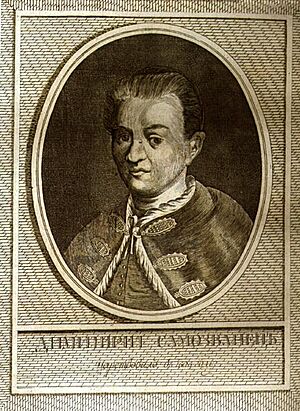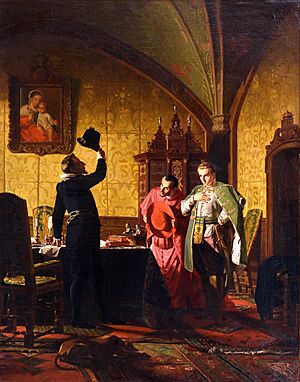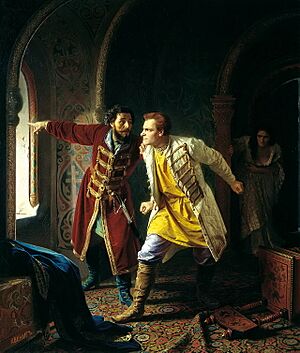False Dmitry I facts for kids
Quick facts for kids False Dmitry IЛжедмитрий I |
|||||
|---|---|---|---|---|---|
 |
|||||
| Tsar of all Russia | |||||
| Reign | 10 June 1605 – 17 May 1606 | ||||
| Coronation | 21 July 1605 | ||||
| Predecessor | Feodor II | ||||
| Successor | Vasili IV | ||||
| Born | 19 October 1582 (claimed) | ||||
| Died | 17 May 1606 (aged 23) Moscow, Russia |
||||
| Spouse | Marina Mniszech | ||||
|
|||||
| Dynasty | Rurik (claimed) | ||||
| Signature |  |
||||
False Dmitry I was a man who claimed to be the rightful ruler of Russia. He became the Tsar of all Russia and ruled from June 10, 1605, to May 17, 1606. His real name is unknown, but he used the name Dmitriy Ivanovich.
He was the first of three "pretenders" during a difficult time in Russian history called the Time of Troubles. These pretenders all claimed to be Dmitry of Uglich, the youngest son of Ivan the Terrible. The real Dmitry was thought to have died in 1591 when he was eight years old.
False Dmitry I said that his mother, Maria Nagaya, helped him escape an assassination attempt. He claimed that someone else was killed instead of him. He then fled to the Polish–Lithuanian Commonwealth. Many Polish nobles did not fully believe his story, but they still decided to support him.
With help from the Polish–Lithuanian Commonwealth, False Dmitry invaded Russia in 1605. The war ended when the current tsar, Boris Godunov, suddenly died. Some powerful Russian nobles, called boyars, then removed the new tsar, Feodor II. False Dmitry entered Moscow on July 21, 1605, and was crowned tsar. Even Maria Nagaya, the real Dmitry's mother, accepted him as her son.
False Dmitry's rule was unpopular because he was open to Catholicism and allowed many foreigners into Russia. The boyars did not like this. They planned a successful takeover and killed him just eleven months after he became tsar. His wife, Marina, later accepted another pretender, False Dmitry II, as her husband.
Contents
Who Was False Dmitry I?
Dmitry first appeared around the year 1600. He impressed the head of the Russian Church, Patriarch Job of Moscow, with his knowledge. Tsar Boris Godunov heard about him and ordered him to be questioned. Dmitry escaped to a Polish noble's home in the Polish–Lithuanian Commonwealth.
He then worked for the Wiśniowiecki family, who were powerful Polish nobles. Two princes, Adam and Michał Wiśniowiecki, became very interested in Dmitry's story. They saw his claim as a chance for Poland to get involved in Russian politics during the Time of Troubles.
His Claim to the Throne
Some rumors said Dmitry was the secret son of the Polish king, Stefan Batory. Dmitry himself claimed that his mother, Tsar Ivan's widow, knew about Boris Godunov's plan to kill him. She supposedly put him in the care of a doctor who hid him in different monasteries. After the doctor died, Dmitry said he fled to Poland.
He worked as a teacher there before joining the Wiśniowiecki family. Some people who had known Ivan IV later said that Dmitry looked like the young prince. Dmitry also had skills like horsemanship and could read and write. He spoke Russian, Polish, and French fluently.
Whether Dmitry's story was true or not, several Polish nobles decided to support his claim against Tsar Boris Godunov.
Gaining Support
In March 1604, Dmitry visited the court of Sigismund III Vasa, the king of Poland. The king gave him some support but did not promise military help. To get the powerful Jesuits (a Catholic religious group) on his side, Dmitry publicly became a Catholic on April 17, 1604. He also convinced a representative of the Pope to support him.
While at court, Dmitry met Marina Mniszech, the daughter of a Polish nobleman. Dmitry and Marina fell in love. When he asked her father if he could marry her, he was promised her hand. In return, Dmitry promised to give the Mniszech family control over several Russian towns if he became tsar. These towns included Pskov, Novgorod, Smolensk, and Novhorod-Siverskyi.
Becoming Tsar
Boris Godunov heard about Dmitry's Polish support. He spread rumors that Dmitry was just a runaway monk named Grigory Otrepyev. It's not clear where this information came from. However, the tsar's public support began to weaken. Dmitry's supporters spread their own rumors against Boris. Several Russian boyars also promised their loyalty to Dmitry. This gave them a reason not to pay taxes to Tsar Boris.
Dmitry, with the full support of the Polish Commonwealth, gathered a small army. It had about 3,500 soldiers from various Polish and Lithuanian groups. With his army, he marched towards Russia in March 1605. Many of Boris's enemies, including the southern Cossacks, joined Dmitry's army.
These combined forces fought two battles against the Russian soldiers. They won the first battle and captured several towns like Chernihiv and Kursk. However, they lost the second battle badly. Their cause was saved only by the sudden death of Boris Godunov on April 13, 1605.
The death of the unpopular tsar removed the last obstacle for Dmitry. The Russian troops who had won the battle against him now joined his side. More people joined the Polish forces as they marched on. On June 1, the unhappy boyars in Moscow staged a takeover. They imprisoned the newly crowned tsar Feodor II and his mother.
On June 20, Dmitry entered Moscow in triumph with many Cossacks and Poles. On July 21, he was crowned tsar by a new head of the Russian Church, Ignatius of Moscow, whom Dmitry had chosen.
His Time as Ruler

The new tsar worked to make his power stronger. He visited the tomb of Tsar Ivan and the convent where Ivan's widow, Maria Nagaya, lived. She accepted him as her son and confirmed his story. The Godunov family members, including Tsar Feodor and his mother, were killed. Many noble families that Tsar Boris had sent away, like the Shuisky and Romanov families, were pardoned. They were allowed to return to Moscow. Feodor Romanov, who would later be the ancestor of future Russian emperors, was made a high-ranking church leader. The old patriarch, Job, who did not recognize the new tsar, was sent away.
Dmitry planned to make many changes to Russia's government and economy. He brought back a special day called Yuri's Day. On this day, serfs (peasants tied to the land) were allowed to change their lord. This made life easier for the peasants. One of his favorite people at court, Prince Ivan Khvorostinin, is seen by historians as one of the first Russians to be interested in Western ideas.
In his foreign policy, Dmitry wanted to make an alliance with Poland and the Papal States (lands ruled by the Pope). He planned to go to war against the Ottoman Empire. He ordered many firearms to be made for this conflict. In his letters, he called himself "Emperor of Russia". This was a century before Tsar Peter I officially used that title. Dmitry's pictures showed him clean-shaven with slicked-back dark hair, which was an unusual look for a Russian ruler at that time.
On May 8, 1606, Dmitry married Marina Mniszech in Moscow. She was Catholic. Usually, when a Russian Tsar married a woman of another faith, she would convert to Eastern Orthodox Christianity. But rumors spread that Dmitry had promised the Polish king and the Pope that he would reunite the Russian Orthodox Church and the Holy See (the Pope's authority). So, it was said, Tsarina Marina did not convert. This made the Russian Orthodox Church, the boyars, and the people very angry.
The resentful Prince Vasily Shuisky, a leader of the boyars, began to plot against the tsar. He accused Dmitry of spreading Catholicism and Lutheranism. This idea gained support, especially because Dmitry surrounded himself with foreigners. These foreigners did not follow Russian customs, which conservative Russian society did not like. Some Russian writers claimed that Dmitry also angered many people by letting his Catholic and Protestant soldiers pray in Orthodox churches.
Shuisky's supporters spread a rumor that Tsar Dmitry was about to order his Polish guards to lock the city gates and kill the people of Moscow. Whether this was true or not, the rumor was widely believed.
His Downfall
On the morning of May 17, 1606, just ten days after Dmitry's marriage, many boyars and common people stormed the Kremlin. Dmitry tried to escape by jumping out a window, but he broke his leg. He tried to hide in a bathhouse. However, he was recognized and dragged out by the boyars, who then killed him.
Dmitry's rule had lasted only eleven months. After his death, Prince Shuisky took his place as tsar. Later, two more people would claim to be Dmitry: False Dmitry II and False Dmitry III.
See also
 In Spanish: Dimitri I para niños
In Spanish: Dimitri I para niños
- Bibliography of Russian history (1223–1613)
- Ivan Bolotnikov
- Isaac Massa
- Polish–Muscovite War (1605–18)
- Battle of Novhorod-Siverskyi
- Battle of Dobrynichi
- Siege of Kromy
- Tsars of Russia family tree


